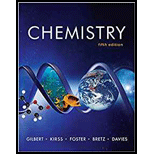
Concept explainers
(a)
Interpretation: The molecular ions with one or more unpaired electron from the given molecules are to be identified.
Concept introduction: When two atomic orbitals come close to each other they lose their identity and form new pair of orbitals knows as molecular orbitals. Among the two molecular orbitals formed, one has energy lower than the atomic orbitals is known as bonding molecular orbital and the other has energy higher than the atomic orbitals and is known as antibonding molecular orbital. The filling electrons in molecular orbitals follow Aufbau’s principle and Hund’s rule.
To determine: If the molecular ion
(a)
Answer to Problem 9.105QP
Solution
The
Explanation of Solution
Explanation
Nitrogen has five valence electrons.
The total number of valence electrons in
According to the molecular orbital theory, the electronic configuration of
One unpaired electron is present in
(b)
To determine: If the molecular ion
(b)
Answer to Problem 9.105QP
Solution
The
Explanation of Solution
Explanation
Oxygen has six valence electrons.
The total number of valence electrons in
According to the molecular orbital theory the electronic configuration of
One unpaired electron is present in the
(c)
To determine: If the molecular ion
(c)
Answer to Problem 9.105QP
Solution
The
Explanation of Solution
Explanation
Carbon has four valence electrons.
The total number of valence electrons in
According to the molecular orbital theory the electronic configuration of
One unpaired electron is present in the
(d)
To determine: If the molecular ion
(d)
Answer to Problem 9.105QP
Solution
The
Explanation of Solution
Explanation
Bromine has seven valence electrons.
The total number of valence electrons in
According to the molecular orbital theory the electronic configuration of
No unpaired electron is present in any orbital of
(e)
To determine: If the molecular ion
(e)
Answer to Problem 9.105QP
Solution
The
Explanation of Solution
Explanation
Oxygen has six valence electrons.
The total number of valence electrons in
According to the molecular orbital theory the electronic configuration of
One unpaired electron is present in the
(f)
To determine: If the molecular ion
(f)
Answer to Problem 9.105QP
Solution
The
Explanation of Solution
Explanation
Oxygen has six valence electrons.
The total number of valence electrons in
According to the molecular orbital theory the electronic configuration of
No unpaired electron is present in any orbital of
(g)
To determine: If the molecular ion
(g)
Answer to Problem 9.105QP
Solution
The
Explanation of Solution
Explanation
Nitrogen has five valence electrons.
The total number of valence electrons in
According to the molecular orbital theory the electronic configuration of
Two unpaired electrons are present in
(h)
To determine: If the molecular ion
(h)
Answer to Problem 9.105QP
Solution
The
Explanation of Solution
Explanation
Fluorine has seven valence electrons.
The total number of valence electrons in
According to the molecular orbital theory the electronic configuration of
One unpaired electron is present in
Conclusion
The molecules which contain unpaired electrons in their molecular orbitals are paramagnetic in nature. All the molecular ion species except
Want to see more full solutions like this?
Chapter 9 Solutions
CHEMISTRY:SCI.IN CONTEXT (CL)-PACKAGE
- What is the final product when hexanedioic acid reacts with 1º PCl5 and 2º NH3.arrow_forwardWhat is the final product when D-galactose reacts with hydroxylamine?arrow_forwardIndicate the formula of the product obtained by reacting methyl 5-chloro-5-oxopentanoate with 1 mole of 4-penten-1-ylmagnesium bromide.arrow_forward
- The temperature on a sample of pure X held at 1.25 atm and -54. °C is increased until the sample boils. The temperature is then held constant and the pressure is decreased by 0.42 atm. On the phase diagram below draw a path that shows this set of changes. pressure (atm) 2 0 0 200 400 temperature (K) Xarrow_forwardQUESTION: Answer Question 5: 'Calculating standard error of regression' STEP 1 by filling in all the empty green boxes *The values are all provided in the photo attached*arrow_forwardpressure (atm) 3 The pressure on a sample of pure X held at 47. °C and 0.88 atm is increased until the sample condenses. The pressure is then held constant and the temperature is decreased by 82. °C. On the phase diagram below draw a path that shows this set of changes. 0 0 200 temperature (K) 400 аarrow_forward
 ChemistryChemistryISBN:9781305957404Author:Steven S. Zumdahl, Susan A. Zumdahl, Donald J. DeCostePublisher:Cengage Learning
ChemistryChemistryISBN:9781305957404Author:Steven S. Zumdahl, Susan A. Zumdahl, Donald J. DeCostePublisher:Cengage Learning ChemistryChemistryISBN:9781259911156Author:Raymond Chang Dr., Jason Overby ProfessorPublisher:McGraw-Hill Education
ChemistryChemistryISBN:9781259911156Author:Raymond Chang Dr., Jason Overby ProfessorPublisher:McGraw-Hill Education Principles of Instrumental AnalysisChemistryISBN:9781305577213Author:Douglas A. Skoog, F. James Holler, Stanley R. CrouchPublisher:Cengage Learning
Principles of Instrumental AnalysisChemistryISBN:9781305577213Author:Douglas A. Skoog, F. James Holler, Stanley R. CrouchPublisher:Cengage Learning Organic ChemistryChemistryISBN:9780078021558Author:Janice Gorzynski Smith Dr.Publisher:McGraw-Hill Education
Organic ChemistryChemistryISBN:9780078021558Author:Janice Gorzynski Smith Dr.Publisher:McGraw-Hill Education Chemistry: Principles and ReactionsChemistryISBN:9781305079373Author:William L. Masterton, Cecile N. HurleyPublisher:Cengage Learning
Chemistry: Principles and ReactionsChemistryISBN:9781305079373Author:William L. Masterton, Cecile N. HurleyPublisher:Cengage Learning Elementary Principles of Chemical Processes, Bind...ChemistryISBN:9781118431221Author:Richard M. Felder, Ronald W. Rousseau, Lisa G. BullardPublisher:WILEY
Elementary Principles of Chemical Processes, Bind...ChemistryISBN:9781118431221Author:Richard M. Felder, Ronald W. Rousseau, Lisa G. BullardPublisher:WILEY





